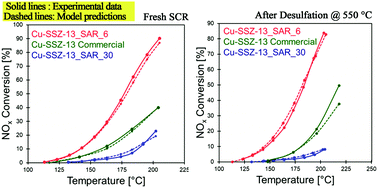当前位置:
X-MOL 学术
›
React. Chem. Eng.
›
论文详情
Our official English website, www.x-mol.net, welcomes your feedback! (Note: you will need to create a separate account there.)
Mechanism-based kinetic modeling of Cu-SSZ-13 sulfation and desulfation for NH3-SCR applications†
Reaction Chemistry & Engineering ( IF 3.9 ) Pub Date : 2018-10-26 00:00:00 , DOI: 10.1039/c8re00210j Yasser Jangjou 1, 2, 3, 4 , Chaitanya S. Sampara 1, 2, 3, 4 , Yuntao Gu 1, 2, 3, 4 , Di Wang 4, 5, 6, 7 , Ashok Kumar 4, 5, 6, 7 , Junhui Li 4, 5, 6, 7 , William S. Epling 1, 2, 3, 4
Reaction Chemistry & Engineering ( IF 3.9 ) Pub Date : 2018-10-26 00:00:00 , DOI: 10.1039/c8re00210j Yasser Jangjou 1, 2, 3, 4 , Chaitanya S. Sampara 1, 2, 3, 4 , Yuntao Gu 1, 2, 3, 4 , Di Wang 4, 5, 6, 7 , Ashok Kumar 4, 5, 6, 7 , Junhui Li 4, 5, 6, 7 , William S. Epling 1, 2, 3, 4
Affiliation

|
A multi-site kinetic model was developed to predict the effect of sulfur dioxide on Cu-SSZ-13 for the NH3 selective catalytic reduction (NH3-SCR) of NOx. To develop a mechanism-based kinetic model, two different Cu sites were assumed describing the formation–decomposition of S intermediates i.e. copper bisulfite on ZCuOH (site 1, S1) and ammonium sulfate on Z2Cu (site 2, S2). Transient kinetics of SO2 interactions with Cu-SSZ-13 were simulated, exploiting SO2 and SO2 + NH3 temperature programmed desorption (TPD) experiments. Besides S1 and S2, a 3rd site was assumed to account for the Brønsted acid site and NH3 adsorption on that site. The model also accounts for NH3-SCR activity over fresh, sulfated and regenerated (at 550 °C) Cu-SSZ-13 samples with different Si : Al and Cu : Al ratios. Finally, the model was capable of describing fresh SCR for commercial and prepared samples without tuning any kinetic parameters, but by only varying ZCuOH and ZCu site densities obtained utilizing H2 temperature programmed reduction (H2-TPR) and inductively coupled plasma optical emission spectroscopy (ICP-OES).
中文翻译:

用于NH 3 -SCR应用的Cu-SSZ-13硫化和脱硫的基于机理的动力学建模†
多站点动力学模型的开发是为了预测为NH二氧化硫对Cu-SSZ-13的效果3选择性催化还原(NH 3 -SCR)NO的X。为了建立基于机理的动力学模型,假设使用两个不同的Cu位点来描述S中间体的形成和分解,即ZCuOH上的亚硫酸氢铜(位点1,S1)和Z 2 Cu上的硫酸铵(位点2,S2)。利用SO 2和SO 2 + NH 3模拟了SO 2与Cu-SSZ-13相互作用的瞬态动力学。程序升温脱附(TPD)实验。除S1和S2外,还假设第三个位点是Brønsted酸位点和该位置上NH 3吸附的原因。该模型还说明了在具有不同Si:Al和Cu:Al比例的新鲜,硫酸化和再生(在550°C)Cu-SSZ-13样品上NH 3 -SCR的活性。最后,该模型能够描述商业和制备样品的新鲜SCR,而无需调整任何动力学参数,而仅改变通过使用H 2程序升温还原(H 2 -TPR)和电感耦合等离子体发射光谱法获得的ZCuOH和ZCu位置密度(ICP-OES)。
更新日期:2018-10-26
中文翻译:

用于NH 3 -SCR应用的Cu-SSZ-13硫化和脱硫的基于机理的动力学建模†
多站点动力学模型的开发是为了预测为NH二氧化硫对Cu-SSZ-13的效果3选择性催化还原(NH 3 -SCR)NO的X。为了建立基于机理的动力学模型,假设使用两个不同的Cu位点来描述S中间体的形成和分解,即ZCuOH上的亚硫酸氢铜(位点1,S1)和Z 2 Cu上的硫酸铵(位点2,S2)。利用SO 2和SO 2 + NH 3模拟了SO 2与Cu-SSZ-13相互作用的瞬态动力学。程序升温脱附(TPD)实验。除S1和S2外,还假设第三个位点是Brønsted酸位点和该位置上NH 3吸附的原因。该模型还说明了在具有不同Si:Al和Cu:Al比例的新鲜,硫酸化和再生(在550°C)Cu-SSZ-13样品上NH 3 -SCR的活性。最后,该模型能够描述商业和制备样品的新鲜SCR,而无需调整任何动力学参数,而仅改变通过使用H 2程序升温还原(H 2 -TPR)和电感耦合等离子体发射光谱法获得的ZCuOH和ZCu位置密度(ICP-OES)。


























 京公网安备 11010802027423号
京公网安备 11010802027423号